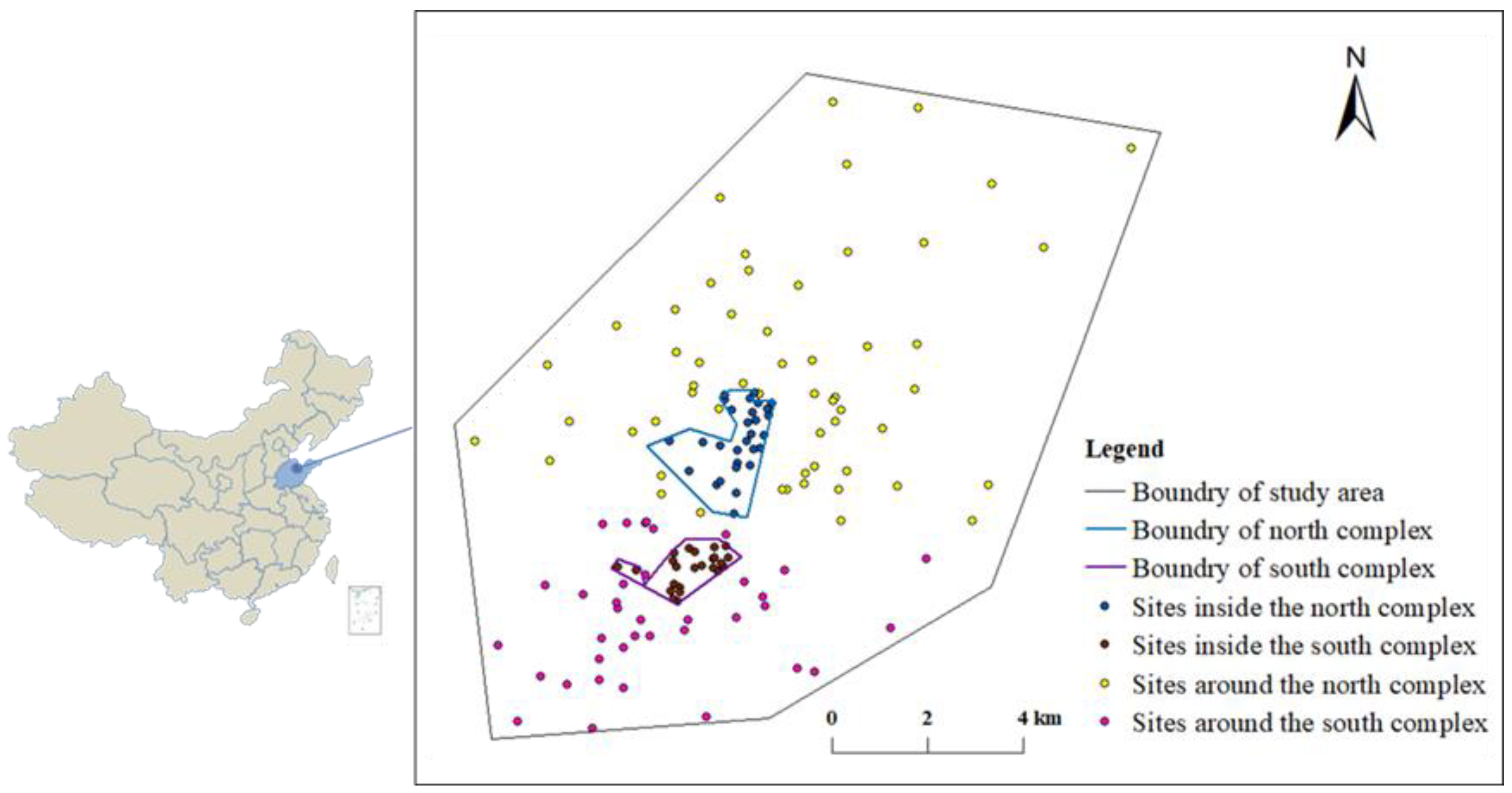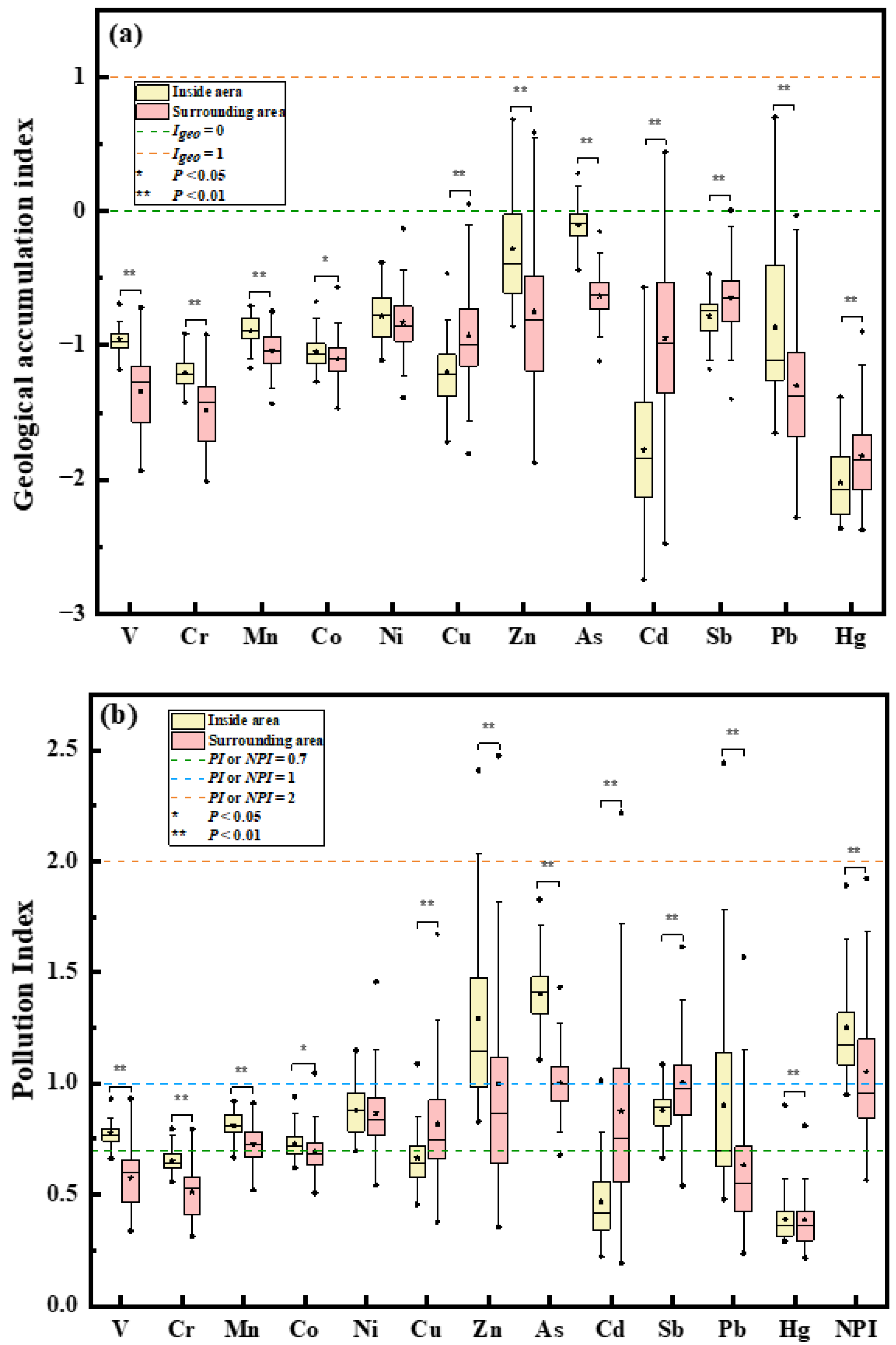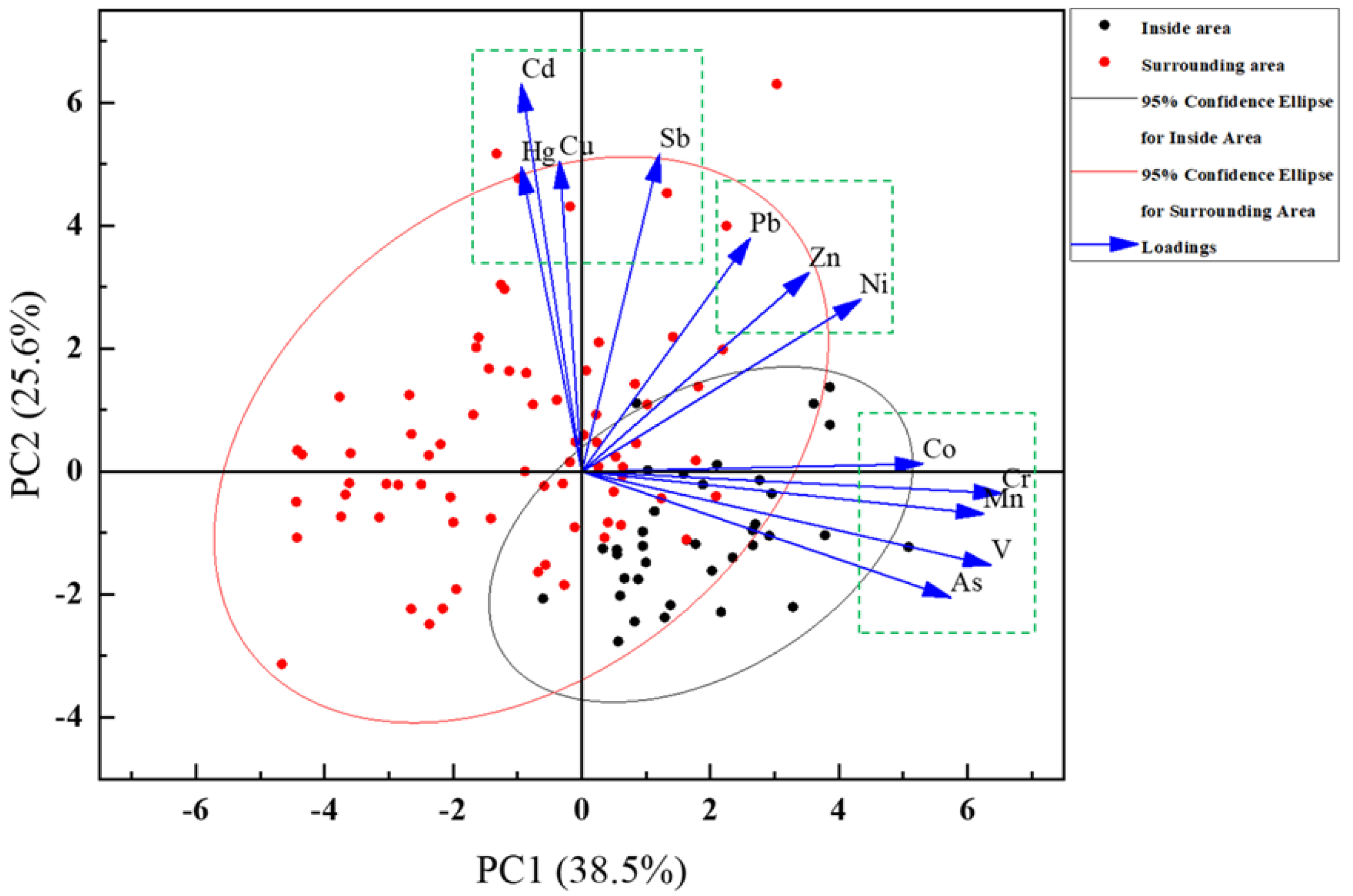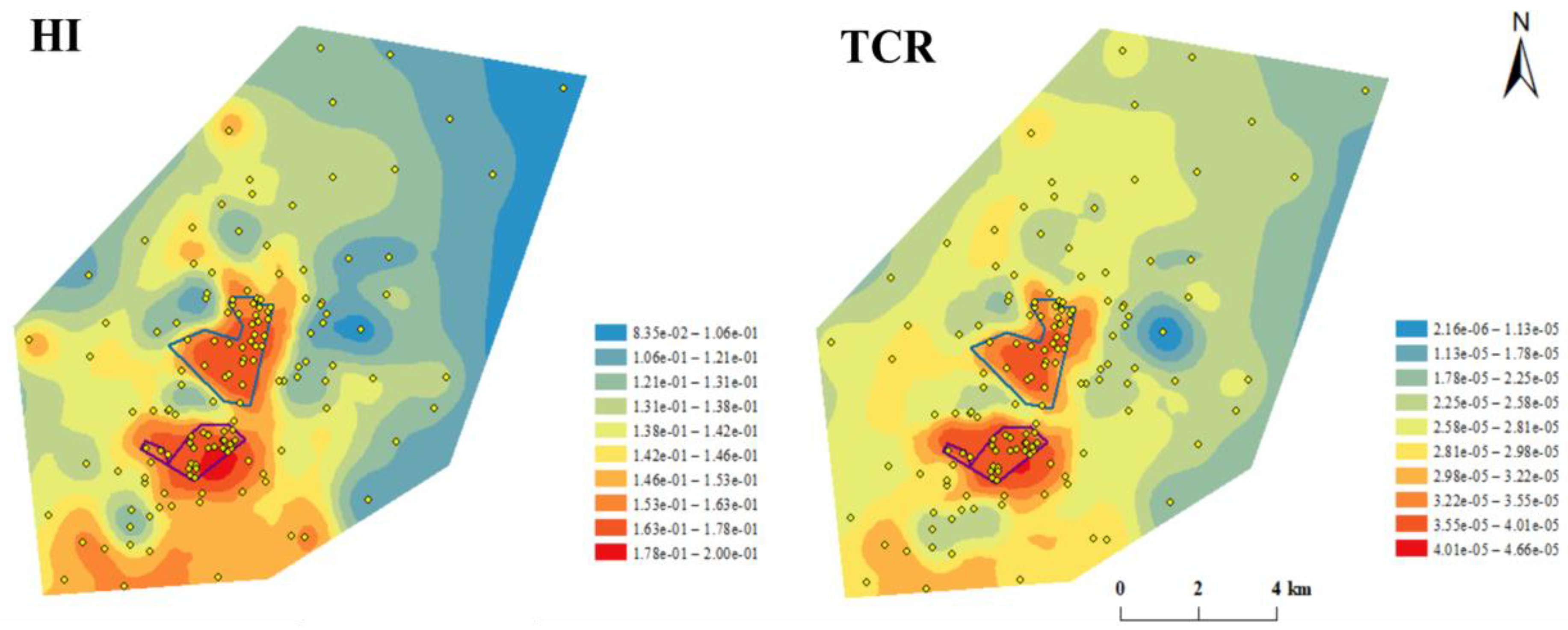Spatial Distribution Profiles and Human-Health Risks of Heavy Metals in Surrounding Area Surface Soils of a Petrochemical Complex
Abstract
1. Introduction
2. Materials and Methods
2.1. Study Area and Sample Collection
2.2. Chemical Analysis
2.3. Quality Assurance and Quality Control
2.4. Data Analysis
2.4.1. Geoaccumulation Index
2.4.2. Nemerow Integrated Pollution Index
2.4.3. Health Risk Assessment
2.4.4. Statistical Analysis
3. Results and Discussion
3.1. HM Concentrations Inside and Around the Petrochemical Complex
3.2. HM Pollution Inside and Around the Petrochemical Complex
3.3. Source Analysis of HMs
3.4. Human Health Risks
3.5. Spatial Distribution of HM Contents and Health Risks
4. Conclusions
Supplementary Materials
Author Contributions
Funding
Institutional Review Board Statement
Informed Consent Statement
Data Availability Statement
Conflicts of Interest
References
- Xiao, Q.; Zong, Y.T.; Lu, S.G. Assessment of heavy metal pollution and human health risk in urban soils of steel industrial city (Anshan), Liaoning, Northeast China. Ecotoxicol. Environ. Saf. 2015, 120, 377–385. [Google Scholar] [CrossRef]
- Hu, B.F.; Shao, S.; Ni, H.; Fu, Z.Y.; Hu, L.S.; Zhou, Y.; Min, X.X.; She, S.F.; Chen, S.C.; Huang, M.X.; et al. Current status, spatial features, health risks, and potential driving factors of soil heavy metal pollution in China at province level. Environ. Pollut. 2020, 266, 114961. [Google Scholar] [CrossRef]
- Zhou, Y.; Jiang, D.; Ding, D.; Wu, Y.; Wei, J.; Kong, L.; Long, T.; Fan, T.; Deng, S. Ecological-health risks assessment and source apportionment of heavy metals in agricultural soils around a super-sized lead-zinc smelter with a long production history, in China. Environ. Pollut. 2022, 307, 119487. [Google Scholar] [CrossRef]
- MEP. Bulletin of National Soil Pollution Survey; MEP: Ministry of Environmental Protection of China: Beijing, China, 2014. (In Chinese)
- Yang, Q.Q.; Li, Z.Y.; Lu, X.N.; Duan, Q.N.; Huang, L.; Bi, J. A review of soil heavy metal pollution from industrial and agricultural regions in China: Pollution and risk assessment. Sci. Total Environ. 2018, 642, 690–700. [Google Scholar] [CrossRef] [PubMed]
- Wang, S.; Yusef Kianpoor, K.; Qin, Z.; Jiao, W. Spatial distribution and assessment of the human health risks of heavy metals in a retired petrochemical industrial area, south China. Environ. Res. 2020, 188, 109661. [Google Scholar] [CrossRef] [PubMed]
- Kim, J.A.; Park, J.H.; Hwang, W.J. Heavy Metal Distribution in Street Dust from Traditional Markets and the Human Health Implications. Int. J. Environ. Res. Public Health 2016, 13, 820. [Google Scholar] [CrossRef]
- Li, J.; Lu, Y.; Yin, W.; Gan, H.; Zhang, C.; Deng, X.; Lian, J. Distribution of heavy metals in agricultural soils near a petrochemical complex in Guangzhou, China. Environ. Monit. Assess. 2008, 153, 365. [Google Scholar] [CrossRef]
- Doabi, S.A.; Karami, M.; Afyuni, M.; Yeganeh, M. Pollution and health risk assessment of heavy metals in agricultural soil, atmospheric dust and major food crops in Kermanshah province, Iran. Ecotoxicol. Environ. Saf. 2018, 163, 153–164. [Google Scholar] [CrossRef]
- Schulin, R.; Curchod, F.; Mondeshka, M.; Daskalova, A.; Keller, A. Heavy metal contamination along a soil transect in the vicinity of the iron smelter of Kremikovtzi (Bulgaria). Geoderma 2007, 140, 52–61. [Google Scholar] [CrossRef]
- Martin, J.A.R.; Gutierrez, C.; Escuer, M.; Garcia-Gonzalez, M.T.; Campos-Herrera, R.; Aguila, N. Effect of mine tailing on the spatial variability of soil nematodes from lead pollution in La Union (Spain). Sci. Total Environ. 2014, 473, 518–529. [Google Scholar] [CrossRef]
- Khademi, H.; Gabarron, M.; Abbaspour, A.; Martinez-Martinez, S.; Faz, A.; Acosta, J.A. Environmental impact assessment of industrial activities on heavy metals distribution in street dust and soil. Chemosphere 2019, 217, 695–705. [Google Scholar] [CrossRef] [PubMed]
- Nadal, M.; Schuhmacher, M.; Domingo, J.L. Levels of metals, PCBs, PCNs and PAHs in soils of a highly industrialized chemical/petrochemical area: Temporal trend. Chemosphere 2007, 66, 267–276. [Google Scholar] [CrossRef] [PubMed]
- Yuan, C.; Pan, Z.; Tan, Z.; Zhang, H. Synthesis of ordered mesoporous alumina and its application in preparation of heavy metal tolerance FCC catalyst. Pet. Process. Petrochem. 2017, 48, 52–55. [Google Scholar]
- Nadal, M.; Schuhmacher, M.; Domingo, J.L. Metal pollution of soils and vegetation in an area with petrochemical industry. Sci. Total Environ. 2004, 321, 59–69. [Google Scholar] [CrossRef]
- Carmela, R.; Patrizia Di, F.; Donatella, P.; Federica, I.; Marco Di, B.; Marco Petrangeli, P.; Sergio, S. Characterization and distribution of petroleum hydrocarbons and heavy metals in groundwater from three Italian tank farms. Sci. Total Environ. 2008, 393, 50–63. [Google Scholar] [CrossRef]
- Schroder, J.L.; Basta, N.T.; Lochmiller, R.L.; Rafferty, D.P.; Payton, M.; Kim, S.; Qualls, C.W. Soil contamination and bioaccumulation of inorganics on petrochemical sites. Environ. Toxicol. Chem. 2000, 19, 2066–2072. [Google Scholar] [CrossRef]
- Bosco, M.L.; Varrica, D.; Dongarra, G. Case study: Inorganic pollutants associated with particulate matter from an area near a petrochemical plant. Environ. Res. 2005, 99, 18–30. [Google Scholar] [CrossRef]
- Wang, W.; Lai, Y.; Ma, Y.; Liu, Z.; Wang, S.; Hong, C. Heavy metal contamination of urban topsoil in a petrochemical industrial city in Xinjiang, China. J. Arid. Land 2016, 8, 871–880. [Google Scholar] [CrossRef]
- Relic, D.; Dordevic, D.; Sakan, S.; Andelkovic, I.; Miletic, S.; Duricic, J. Aqua regia extracted metals in sediments from the industrial area and surroundings of Pancevo, Serbia. J. Hazard. Mater. 2011, 186, 1893–1901. [Google Scholar] [CrossRef]
- Relic, D.; Sakan, S.; Andelkovic, I.; Popovic, A.; Dordevic, D. Pollution and Health Risk Assessments of Potentially Toxic Elements in Soil and Sediment Samples in a Petrochemical Industry and Surrounding Area. Molecules 2019, 24, 2139. [Google Scholar] [CrossRef]
- Muller, G. Index of geoaccumulation in sediments of the rhine river. GeoJournal 1969, 6, 108–118. [Google Scholar]
- Massas, I.; Kalivas, D.; Ehaliotis, C.; Gasparatos, D. Total and available heavy metal concentrations in soils of the Thriassio plain (Greece) and assessment of soil pollution indexes. Environ. Monit. Assess. 2013, 185, 6751–6766. [Google Scholar] [CrossRef] [PubMed]
- Wei, B.; Yang, L. A review of heavy metal contaminations in urban soils, urban road dusts and agricultural soils from China. Microchem. J. 2010, 94, 99–107. [Google Scholar] [CrossRef]
- Yu, G.; Chen, F.; Zhang, H.; Wang, Z. Pollution and health risk assessment of heavy metals in soils of Guizhou, China. Ecosyst. Health Sustain. 2021, 7, 1859948. [Google Scholar] [CrossRef]
- Pang, X.; Dai, J.; Chen, L.; Liu, H.; Yu, C.; Han, L.; Ren, T.; Hu, X.; Wang, H.; Wang, Z.; et al. Soil geochemical background value of 17 cities in Shandong Province. Shandong Land Resour. 2019, 35, 46–56. (In Chinese) [Google Scholar]
- Nemerow, N.L. Scientific Stream Pollution Analysis; McGraw-Hill Book Company: New York, NY, USA, 1974. [Google Scholar]
- Wang, J.X.; Wu, L.B.; Deng, Y.S.; Song, D.S.; Liu, W.J.; Hu, M.Z.; Liu, X.T.; Zhou, J. Investigation and evaluation of contamination in dredged reclaimed land in China. Mar. Georesources Geotechnol. 2018, 36, 603–616. [Google Scholar] [CrossRef]
- Osei, L.B.; Fosu, S.; Ndur, S.A.; Nyarko, S.Y. Assessing heavy metal contamination and ecological risk of urban topsoils in Tarkwa, Ghana. Environ. Monit. Assess. 2022, 194, 710. [Google Scholar] [CrossRef]
- Li, S.Z.; Zhao, B.; Jin, M.; Hu, L.; Zhong, H.; He, Z.G. A comprehensive survey on the horizontal and vertical distribution of heavy metals and microorganisms in soils of a Pb/Zn smelter. J. Hazard. Mater. 2020, 400, 123255. [Google Scholar] [CrossRef]
- USEPA. Human Health Evaluation Manual, Supplemental Guidance: Update of Standard Default Exposure Factors; U.S. Environment Protection Agency: Washington, DC, USA, 1989.
- USEPA. Risk Assessment Guidance for Superfund Volume I: Human Health Evaluation Manual (Part A); U.S. Environment Protection Agency: Washington, DC, USA, 1989.
- Trinkel, V.; Kieberger, N.; Burgler, T.; Rechberger, H.; Fellner, J. Influence of waste plastic utilisation in blast furnace on heavy metal emissions. J. Clean. Prod. 2015, 94, 312–320. [Google Scholar] [CrossRef]
- Keshavarzi, A.; Kumar, V. Ecological risk assessment and source apportionment of heavy metal contamination in agricultural soils of Northeastern Iran. Int. J. Environ. Health Res. 2019, 29, 544–560. [Google Scholar] [CrossRef]
- Bortey-Sam, N.; Nakayama, S.M.M.; Akoto, O.; Ikenaka, Y.; Baidoo, E.; Mizukawa, H.; Ishizuka, M. Ecological Risk of Heavy Metals and a Metalloid in Agricultural Soils in Tarkwa, Ghana. Int. J. Environ. Res. Public Health 2015, 12, 11448–11465. [Google Scholar] [CrossRef]
- Wong, S.C.; Li, X.D.; Zhang, G.; Qi, S.H.; Min, Y.S. Heavy metals in agricultural soils of the Pearl River Delta, South China. Environ. Pollut. 2002, 119, 33–44. [Google Scholar] [CrossRef] [PubMed]
- Jixin, Y.; Huawei, D.; Yingjun, W.; Jiaming, G.; Fangming, L.; Yulong, P.; Minghong, L.; Jun, Q.; Jiguang, Z. Distribution Characteristics of Medium and Trace Elements and Risk Assessments for Heavy Metals in Soils in Zibo Tobacco-planting Region. Chin. Tob. Sci. 2020, 41, 44–50. (In Chinese) [Google Scholar] [CrossRef]
- Luo, L.; Ma, Y.B.; Zhang, S.Z.; Wei, D.P.; Zhu, Y.G. An inventory of trace element inputs to agricultural soils in China. J. Environ. Manag. 2009, 90, 2524–2530. [Google Scholar] [CrossRef] [PubMed]
- Ozaki, H.; Watanabe, I.; Kuno, K. Investigation of the heavy metal sources in relation to automobiles. Water Air Soil Pollut. 2004, 157, 209–223. [Google Scholar] [CrossRef]
- Qi, J.; Zhang, H.; Du, Y.; Gao, B. Corrosion Research of Naphthenic Acide in Distillates of Shengli High Acide Crude. Pet. Process. Petrochenmicals 2015, 46, 88–92. (In Chinese) [Google Scholar]
- Zhang, Q.; Tian, S.; Lin, Y.; Liu, Y. Effect of True Boiling Point Distillation on the Corrosivity of Two Kinds of High-Acide Crude Oils and Its Characterization. Acta Pet. Sin. (Pet. Process. Sect.) 2022, 38, 695–701. (In Chinese) [Google Scholar]
- Memoli, V.; Esposito, F.; Panico, S.C.; De Marco, A.; Barile, R.; Maisto, G. Evaluation of tourism impact on soil metal accumulation through single and integrated indices. Sci. Total Environ. 2019, 682, 685–691. [Google Scholar] [CrossRef]
- Liu, X.Y.; Bai, Z.K.; Shi, H.D.; Zhou, W.; Liu, X.C. Heavy metal pollution of soils from coal mines in China. Nat. Hazards 2019, 99, 1163–1177. [Google Scholar] [CrossRef]
- Cui, X.W.; Geng, Y.; Sun, R.R.; Xie, M.; Feng, X.W.; Li, X.X.; Cui, Z.J. Distribution, speciation and ecological risk assessment of heavy metals in Jinan Iron & Steel Group soils from China. J. Clean. Prod. 2021, 295, 126504. [Google Scholar] [CrossRef]
- Qiu, M.L.; Li, F.B.; Wang, Q.; Chen, J.J.; Yang, G.Y.; Liu, L.M. Driving forces of heavy metal changes in agricultural soils in a typical manufacturing center. Environ. Monit. Assess. 2015, 187, 239. [Google Scholar] [CrossRef] [PubMed]
- Guo, X.D.; Zhao, Y.S.; He, H.Y.; Wang, X.G. Potential ecological risk assessment of soil heavy metals in Hunchun basin, Northeast China. Arab. J. Geosci. 2020, 13, 56. [Google Scholar] [CrossRef]
- Xu, L.; Dai, H.P.; Skuza, L.; Wei, S.H. Comprehensive exploration of heavy metal contamination and risk assessment at two common smelter sites. Chemosphere 2021, 285, 131350. [Google Scholar] [CrossRef] [PubMed]
- Zhao, X.; Wang, Q.; Ningning, S.H.I.; Ding, Y. Analysis and assessment of soil heavy metals around a petrochemical industry park. Acta Sci. Circumstantiae 2010, 30, 133–141. (In Chinese) [Google Scholar]
- Taylor, M.D. Accumulation of cadmium derived from fertilisers in New Zealand soils. Sci. Total Environ. 1997, 208, 123–126. [Google Scholar] [CrossRef] [PubMed]
- Song, B.; Zhang, Y.; Pang, R.; Yang, Z.; Bin, J.; Zhou, Z.; Chen, T. Analysis of Characteristics and Sources of Heavy Metals in Farmland Soils in the Xijiang River Draining of Guangxi. Environ. Sci. 2018, 39, 4317–4326. (In Chinese) [Google Scholar] [CrossRef]
- Chen, T.; Liu, X.; Zhu, M.; Zhao, K.; Wu, J.; Xu, J.; Huang, P. Identification of trace element sources and associated risk assessment in vegetable soils of the urban-rural transitional area of Hangzhou, China. Environ. Pollut. 2008, 151, 67–78. [Google Scholar] [CrossRef]
- Sun, X.; Zhang, L.; Dong, Y.; Zhu, L.; Wang, Z.; Lu, J. Source Apportionment and Spatial Distribution Simulation of Heavy Metals in a Typical Petrochemical Industrial City. Environ. Sci. 2021, 42, 1093–1104. [Google Scholar] [CrossRef]
- Manno, E.; Varrica, D.; Dongarra, G. Metal distribution in road dust samples collected in an urban area close to a petrochemical plant at Gela, Sicily. Atmos. Environ. 2006, 40, 5929–5941. [Google Scholar] [CrossRef]
- Ahmad, I.; Rashid, H.; Rehman, Z.U. Study of heavy metals in some environmental samples. Environ. Monit. Assess. 2009, 158, 139–144. [Google Scholar] [CrossRef]
- Liu, T.T.; Hu, W.Z.; Wang, G.F.; Xue, J.P. Assessment of Heavy Metal Pollution in Soil Around a plastic metal factory in Jiaxing, China. In Proceedings of the 5th International Conference on Advances in Energy Resources and Environment Engineering (ICAESEE), Chongqing, China, 6–8 December 2019. [Google Scholar]
- Wu, X.; Li, L.; Pan, G.; Ju, Y.; Jiang, H. Soil pollution of Cu, Zn, Pb and Cd in different city zones of Nanjing. Huan Jing Ke Xue Huanjing Kexue 2003, 24, 105–111. (In Chinese) [Google Scholar] [PubMed]
- Zhang, X.; Lin, Y.; Yu, F.; Li, B. Pollution of heavy metals in urban soils of typical industrial and surrounding residential area in Nanjing city. Resour. Environ. Yangtze Basin 2005, 14, 512–515. (In Chinese) [Google Scholar]
- Ferreira-Baptista, L.; De Miguel, E. Geochemistry and risk assessment of street dust in Luanda, Angola: A tropical urban environment. Atmos. Environ. 2005, 39, 4501–4512. [Google Scholar] [CrossRef]
- Sapcanin, A.; Smajovic, A.; Pehlic, E.; Salihovic, M.; Jancan, G. Health Risk Assessments Based on the Contents of Heavy Metals in Sarajevo Urban Soil. In International Conference “New Technologies, Development and Applications”; Springer: Cham, Switzerland, 2019; pp. 595–603. [Google Scholar]
- Yang, S.Y.; Zhao, J.; Chang, S.X.; Collins, C.; Xu, J.M.; Liu, X.M. Status assessment and probabilistic health risk modeling of metals accumulation in agriculture soils across China: A synthesis. Environ. Int. 2019, 128, 165–174. [Google Scholar] [CrossRef]
- Han, J.; Lee, S.; Mammadov, Z.; Kim, M.; Mammadov, G.; Ro, H.M. Source apportionment and human health risk assessment of trace metals and metalloids in surface soils of the Mugan Plain, the Republic of Azerbaijan. Environ. Pollut. 2021, 290, 118058. [Google Scholar] [CrossRef]
- Huang, J.L.; Wu, Y.Y.; Sun, J.X.; Li, X.; Geng, X.L.; Zhao, M.L.; Sun, T.; Fan, Z.Q. Health risk assessment of heavy metal(loid)s in park soils of the largest megacity in China by using Monte Carlo simulation coupled with Positive matrix factorization model. J. Hazard. Mater. 2021, 415, 125629. [Google Scholar] [CrossRef]
- Ma, R.; Li, L. ICP-MS Determination of 17 Elements in Sludge from Petroleum Refineries. Phys. Test. Chem. Anal. Part B Chem. Anal. 2014, 50, 730–733. [Google Scholar]
- MEP. Technical Guidelines for Risk Assessment of Contaminated Sites. HJ 25.3-2015. Ministry of Environmental Protection of China. 2019. Available online: https://english.mee.gov.cn/Resources/standards/Soil/Method_Standard4/201605/t20160506_337324.shtml (accessed on 5 December 2019). (in Chinese)
- USEPA. Supplemental Guidance for Developing Soil Screening Levels for Superfund Sites; U.S. Environment Protection Agency: Washington, DC, USA, 2001.




| HMs | Inside Area | Surrounding Area | Background Values [26] | ||||||||
|---|---|---|---|---|---|---|---|---|---|---|---|
| Min | Max | Median | Mean | SD | Min | Max | Median | Mean | SD | ||
| V | 55.2 | 77.4 | 63.9 | 64.7 | 4.46 | 32.7 | 75.9 | 51.8 | 50.0 | 8.80 | 83.2 |
| Cr | 39.5 | 95.8 | 45.6 | 47.1 | 7.59 | 26.3 | 56.1 | 39.7 | 38.6 | 6.54 | 70.8 |
| Mn | 404 | 619 | 494 | 495 | 42.2 | 336 | 542 | 443 | 443 | 45.4 | 605 |
| Co | 8.47 | 12.8 | 9.77 | 9.94 | 0.87 | 7.38 | 13.8 | 9.51 | 9.55 | 0.10 | 13.6 |
| Ni | 22.2 | 103 | 28.4 | 31.2 | 13.0 | 18.3 | 117 | 26.8 | 28.9 | 11.0 | 32.0 |
| Cu | 13.8 | 34.7 | 18.7 | 19.5 | 4.50 | 12.4 | 56.1 | 22.1 | 24.7 | 8.41 | 28.9 |
| Zn | 63.2 | 4500 | 88.4 | 207 | 604 | 31.3 | 453 | 68.3 | 84.4 | 57.7 | 76.4 |
| As | 11.1 | 18.3 | 14.1 | 14.1 | 1.47 | 6.92 | 15.1 | 9.73 | 9.82 | 1.24 | 10.0 |
| Cd | 0.036 | 0.97 | 0.072 | 0.10 | 0.13 | 0.044 | 0.58 | 0.12 | 0.15 | 0.079 | 0.16 |
| Sb | 0.54 | 2.45 | 0.75 | 0.84 | 0.34 | 0.47 | 2.17 | 0.79 | 0.83 | 0.23 | 0.82 |
| Pb | 13.3 | 81.1 | 19.5 | 26.2 | 14.2 | 8.60 | 87.1 | 16.7 | 20.2 | 12.4 | 27.9 |
| Hg | 0.013 | 0.043 | 0.016 | 0.019 | 0.007 | 0.013 | 0.054 | 0.019 | 0.021 | 0.008 | 0.045 |
| Risk | HMs | Inside Area | Surrounding Area | |
|---|---|---|---|---|
| Adults | Adults | Children | ||
| HI | V | 2.10 × 10−2 | 1.70 × 10−2 | 9.54 × 10−2 |
| Cr | 3.01 × 10−2 | 2.61 × 10−2 | 1.54 × 10−1 | |
| Mn | 2.50 × 10−2 | 2.26 × 10−2 | 1.15 × 10−1 | |
| Co | 8.53 × 10−4 | 8.30 × 10−4 | 5.07× 10−3 | |
| Ni | 2.31 × 10−3 | 2.18 × 10−3 | 1.40 × 10−2 | |
| Cu | 7.64 × 10−4 | 8.92 × 10−4 | 5.71 × 10−3 | |
| Zn | 4.81 × 10−4 | 3.59 × 10−4 | 2.29 × 10−3 | |
| As | 7.69 × 10−2 | 5.30 × 10−2 | 3.40 × 10−1 | |
| Cd | 1.57 × 10−4 | 2.85 × 10−4 | 1.59 × 10−3 | |
| Sb | 3.59 × 10−3 | 3.84 × 10−3 | 2.27 × 10−2 | |
| Pb | 9.24 × 10−3 | 7.68 × 10−3 | 4.87 × 10−2 | |
| Hg | 9.18 × 10−5 | 1.07 × 10−4 | 6.72 × 10−4 | |
| Total | 1.70 × 10−1 | 1.35 × 10−1 | 8.05 × 10−1 | |
| TCR | Cr | 9.50 × 10−7 | 8.26 × 10−7 | 3.98 × 10−6 |
| Co | 1.65 × 10−8 | 1.61 × 10−8 | 2.68 × 10−8 | |
| Ni | 4.07 × 10−9 | 3.85 × 10−9 | 6.41 × 10−9 | |
| As | 3.46 × 10−5 | 2.38 × 10−5 | 1.53 × 10−4 | |
| Cd | 6.68 × 10−7 | 1.21 × 10−6 | 7.82 × 10−6 | |
| Pb | 2.67 × 10−7 | 2.89 × 10−7 | 1.43 × 10−6 | |
| Total | 3.65 × 10−5 | 2.62 × 10−5 | 1.66 × 10−4 | |
Publisher’s Note: MDPI stays neutral with regard to jurisdictional claims in published maps and institutional affiliations. |
© 2022 by the authors. Licensee MDPI, Basel, Switzerland. This article is an open access article distributed under the terms and conditions of the Creative Commons Attribution (CC BY) license (https://creativecommons.org/licenses/by/4.0/).
Share and Cite
Yi, M.; Zhang, S.; Li, M.; Xiang, J.; Tang, B.; Yan, X.; Zheng, J.; Li, G.; An, T. Spatial Distribution Profiles and Human-Health Risks of Heavy Metals in Surrounding Area Surface Soils of a Petrochemical Complex. Int. J. Environ. Res. Public Health 2022, 19, 16930. https://doi.org/10.3390/ijerph192416930
Yi M, Zhang S, Li M, Xiang J, Tang B, Yan X, Zheng J, Li G, An T. Spatial Distribution Profiles and Human-Health Risks of Heavy Metals in Surrounding Area Surface Soils of a Petrochemical Complex. International Journal of Environmental Research and Public Health. 2022; 19(24):16930. https://doi.org/10.3390/ijerph192416930
Chicago/Turabian StyleYi, Miao, Shiyi Zhang, Min Li, Jun Xiang, Bin Tang, Xiao Yan, Jing Zheng, Guiying Li, and Taicheng An. 2022. "Spatial Distribution Profiles and Human-Health Risks of Heavy Metals in Surrounding Area Surface Soils of a Petrochemical Complex" International Journal of Environmental Research and Public Health 19, no. 24: 16930. https://doi.org/10.3390/ijerph192416930
APA StyleYi, M., Zhang, S., Li, M., Xiang, J., Tang, B., Yan, X., Zheng, J., Li, G., & An, T. (2022). Spatial Distribution Profiles and Human-Health Risks of Heavy Metals in Surrounding Area Surface Soils of a Petrochemical Complex. International Journal of Environmental Research and Public Health, 19(24), 16930. https://doi.org/10.3390/ijerph192416930








